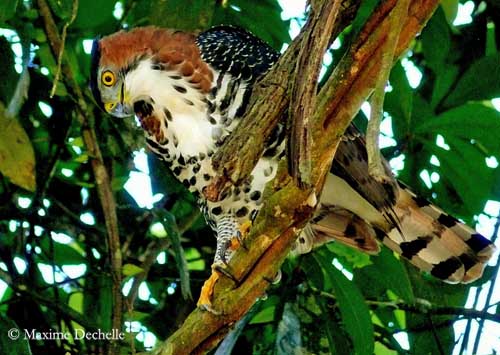
Booted eagles
Genera Spizaetus and Nisaetus
The latest genus of the tenth group of the family Accipitridae includes eleven species according to the different classifications.
Most of them are found in S-SW Asia (Nisaetus - 2015), and the others in Central and South America (Spizaetus).
These eagles have several common features such as long crest, dark upperparts, pale spotted, streaked or barred underparts, well feathered legs, long barred tail and broad rounded wings.
Text by Nicole Bouglouan
Photographers:
Marc Chrétien
MURINUS
Maxime Dechelle
LEPAPARRAZO
Steve Garvie
RAINBIRDER Photo galleries
René Lortie
http://rlortie.ca/
Ingo Waschkies
Bird Photography
Philippe et Aline Wolfer
OISEAUX D'ARGENTINE
Sources:
HANDBOOK OF THE BIRDS OF THE WORLD Vol 2 by Josep del Hoyo-Andrew Elliot-Jordi Sargatal - Lynx Edicions - ISBN: 8487334156
A Field Guide to the Birds of South-East Asia by Craig Robson. New Holland Publishers. ISBN: 9781780090498
Article Booted Eagles - Introduction

Spizaetus ornatus
They are small to medium-sized eagles, from 43-58 cm for the Wallace's Hawk-eagle (Nisaetus nanus) up to 67-86 cm for the Mountain Hawk-eagle (Nisaetus nipalensis), the wingspan of the latter is about 150-165 cm.
The upperparts vary from black in Black Hawk-eagle (Spizaetus tyrannus) and Black-and-chestnut Eagle (Spizaetus isidori), to blackish-brown in Blyth's Hawk-eagle (Spizaetus alboniger), and to dark brown in all other species.
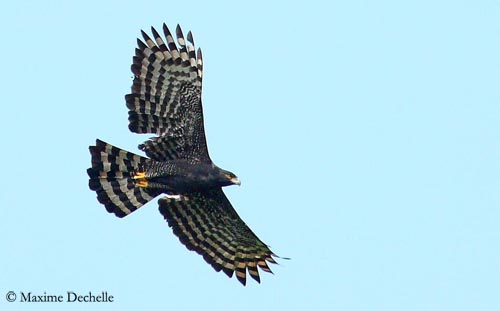
Spizaetus tyrannus
The main exception is the Black-and-white Hawk-eagle (Spizeatus melanoleucus) which has black upperparts and white head, neck and underparts. The tail is black barred pale buff. The short crest is black, as the small mask on lores and around the pale yellow eyes. The bill is black with yellow cere.
The black species have very dark upperparts, whereas the underparts are often barred black and white. The Black Hawk-eagle has black plumage overall, except black and white barring on lower belly, thighs and undertail-coverts.
The Black-and-chestnut Eagle is the only one having chestnut underparts and tarsi and black thighs. The black tail shows broad subterminal whitish band.
They usually have black head and crest, black bill and grey cere, yellow eyes and feet. The Black-and-chestnut eagle has deep orange eyes.
The brown hawk-eagles often have paler head and neck, mostly brownish to pale rufous or chestnut, with narrow streaks. The chin is white. The crest is similar in colour to the head or darker. The bare parts are as in black species.
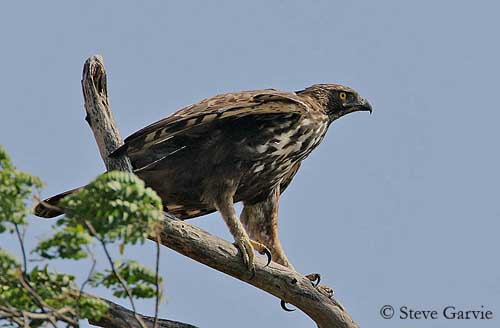
The Changeable Hawk-eagle (Nisaetus cirrhatus) occurs in two morphs, normal and dark, crested or crestless. The race "limnaetus" has dark morph and lacks the long crest. The race "floris" is crestless too, with brown upperparts, pale rufous head and neck and white underparts. Both races are sometimes considered two separate species but they have similar behaviour than other hawk-eagles.
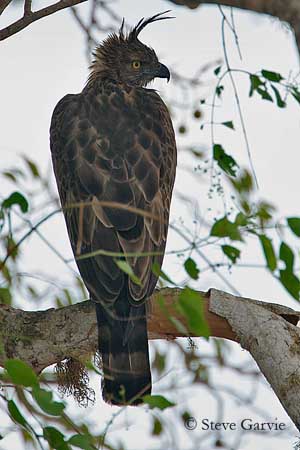
Changeable Hawk-eagle - Nisaetus cirrhatus
The four species of Central and South America are fairly different from each other, but except the Black-and-White Hawk-eagle with its very short crest and black and white plumage, they resemble Asian hawk-eagles.
The eagles of genus Spizaetus frequent the deciduous and evergreen forest often at high altitude, from 250 up to 3000/3500 metres of elevation according to the range and the species.
Some of them such as the Philippine Hawk-eagle (Nisaetus philippensis) and the Wallace's Hawk-eagle prefer the lowland evergreen forest, and the Black-and-white Hawk-eagle can be seen in forest, but more often in areas with some open country or rivers.
They feed on various types of preys, but usually numerous bird species, arboreal and terrestrial mammals, bats, frogs, lizards and snakes. These powerful raptors hunt from perch concealed inside the forest or at forest edge, and this is the typical hunting behaviour of the Hawk-eagles.
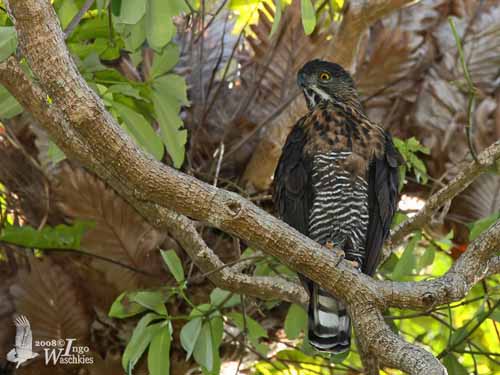
Nisaetus lanceolatus
The prey is caught on the ground after rapid stoop from the perch. But they also perform high soaring flights and take the prey in the canopy.
On the other hand, the Black-and-chestnut Eagle and the Black-and-white Hawk-eagle are rarely seen perched, and hunt mainly in the canopy and by soaring flight.
During the breeding season, several species perform aerial displays. The pair soars over the territory while calling. Some of them have undulating display flight.
The Black Hawk-eagle performs typical raptor's display flight with contact and roll-overs, whereas the displays of the Ornate Hawk-eagle entail calling and diving with folded wings and rising again in the air.
The broad wings allow these powerful eagles to perform spectacular aerial displays.
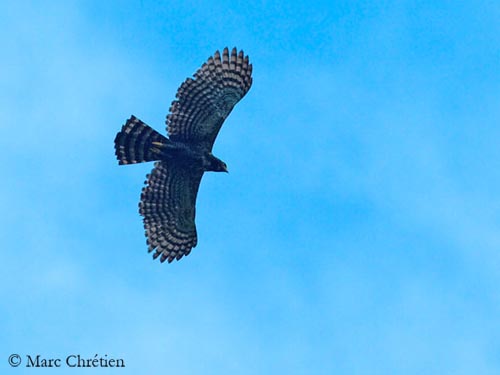
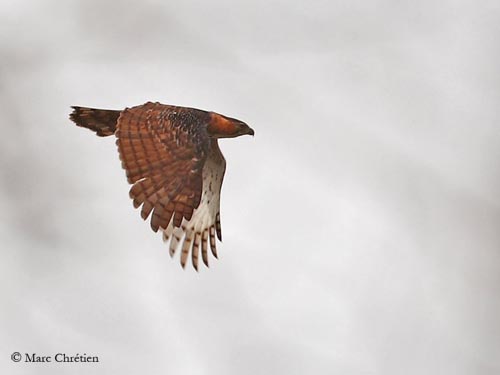
Spizaetus ornatus
Spizaetus tyrannus
The stick nest is often built high above the ground, in the crown or high fork of a large tree in forest. There is usually a single egg. The incubation lasts between 40 and 48 days, mainly by female. The male feeds her during this period, and then, it brings the food at nest but the young are often fed by the female with the preys given by the male.
The young fledge between 65 and 95 days after hatching, but it depends on parents for long time after fledging.
These species do not breed every year, but usually in alternate years or even every third year.
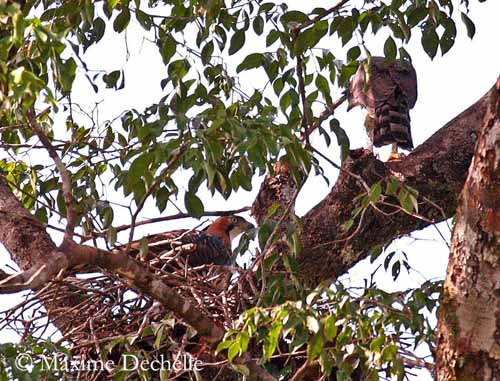
Spizaetus ornatus
This genus includes eleven species with four Central and South American species. The Black Hawk-eagle and the Ornate Hawk-eagle have similar range, from C and S Mexico, through Central America to northern half of South America. Both are sedentary in their wide range.
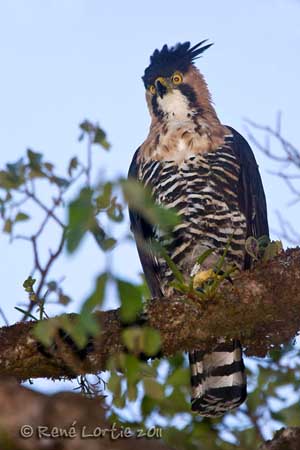
Spizaetus ornatus
The Black-and-chestnut Eagle occurs in western coast of S America, from NW Venezuela and NE Colombia, and S to WC Bolivia and NW Argentina. This species is sedentary too.
The Black-and-white Hawk-eagle is found from E and S Mexico, through Central America to Colombia, and E through N Venezuela to the Guianas, and S through E and S Brazil to NE Argentina and Paraguay, and also E Peru and N and E Bolivia. There is not information about its movements.
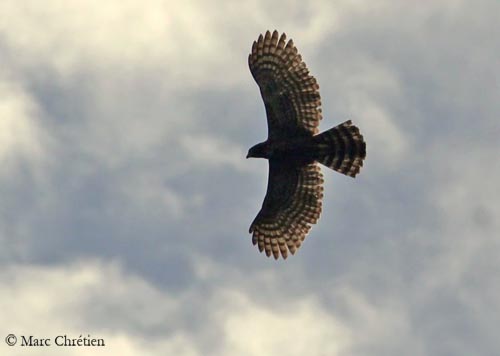
Spizaetus tyrannus
The Asian species are found in India and SE Asia, and their subspecies are spread into several islands in this area. All are apparently sedentary in their range, except the Mountain Hawk-Eagle which performs some movements in winter. The species is common in lowlands of Thailand in winter, and some individuals, probably juveniles, reach the Malay Peninsula and the lowlands of Japan.
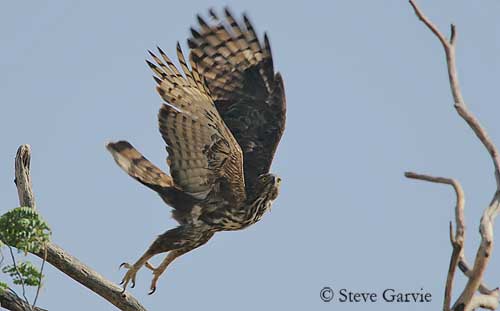
Nisaetus cirrhatus
The Central and South American species are threatened by intensive deforestation. The Black Hawk-eagle and the Ornate Hawk-eagle are relatively common in suitable habitat, and in spite of local declines, their populations are not currently threatened.
However, the Black-and-white Hawk-eagle and the Black-and-chestnut Eagle are considered Near-threatened. Both are rare and have spotty distribution due to loss of primary forest.
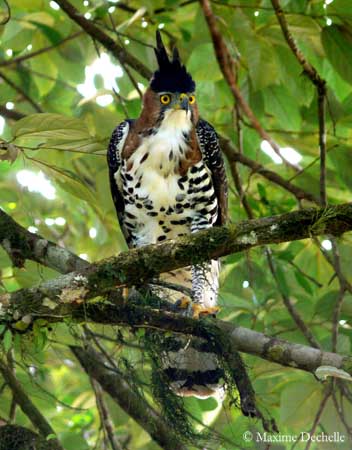
Spizaetus ornatus
In Asian species, the Changeable Hawk-eagle is widespread and fairly common in its range. The Mountain Hawk-eagle, the Blyth’s Hawk-eagle, the Philippine Hawk-eagle and the Sulawesi Hawk-eagle are uncommon to rare. The Javan Hawk-eagle is considered Vulnerable and is one of the rarest of all raptors. The Wallace’s Hawk-eagle is rare too.
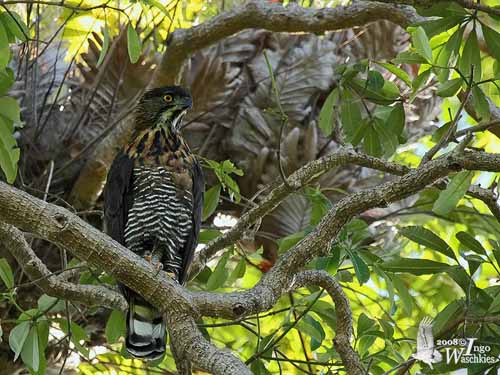
Nisaetus lanceolatus
All these species are threatened by massive and continuing deforestation which disturbs their breeding and feeding habits. Human disturbances and clearance for agriculture expansion involve habitat degradation. Persecution by hunting and trapping are important threats too.
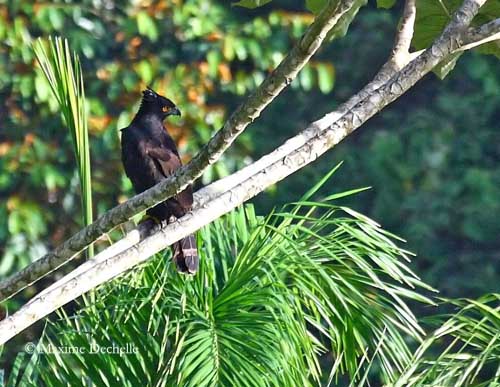
Spizaetus tyrannus
However, these superb raptors are still living in their habitat, and try to breed in spite of numerous threats and disturbances. To see one of them is a wonderful gift, and we must protect them and their habitat if we wish to enjoy their presence in the future.
On the other hand, these eagles show some physical similarities with the raptors of the first group of the Accipitridae. Take a look at the Black Baza… It seems they have come full circle!
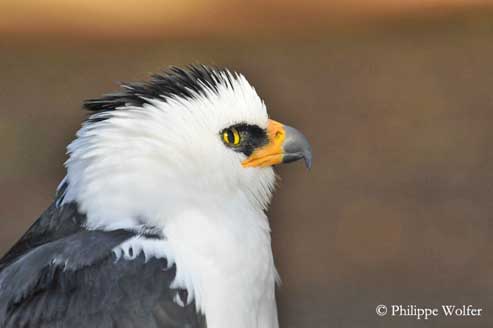
Spizeatus melanoleucus
NOTE:
Some species of the genus Spizaetus are now included in the genus Nisaetus, from the new classification reference (version 5.1, 2015) by American Ornithologists' Union (AOU).
This genus includes the Old World species.
This page is now updated.